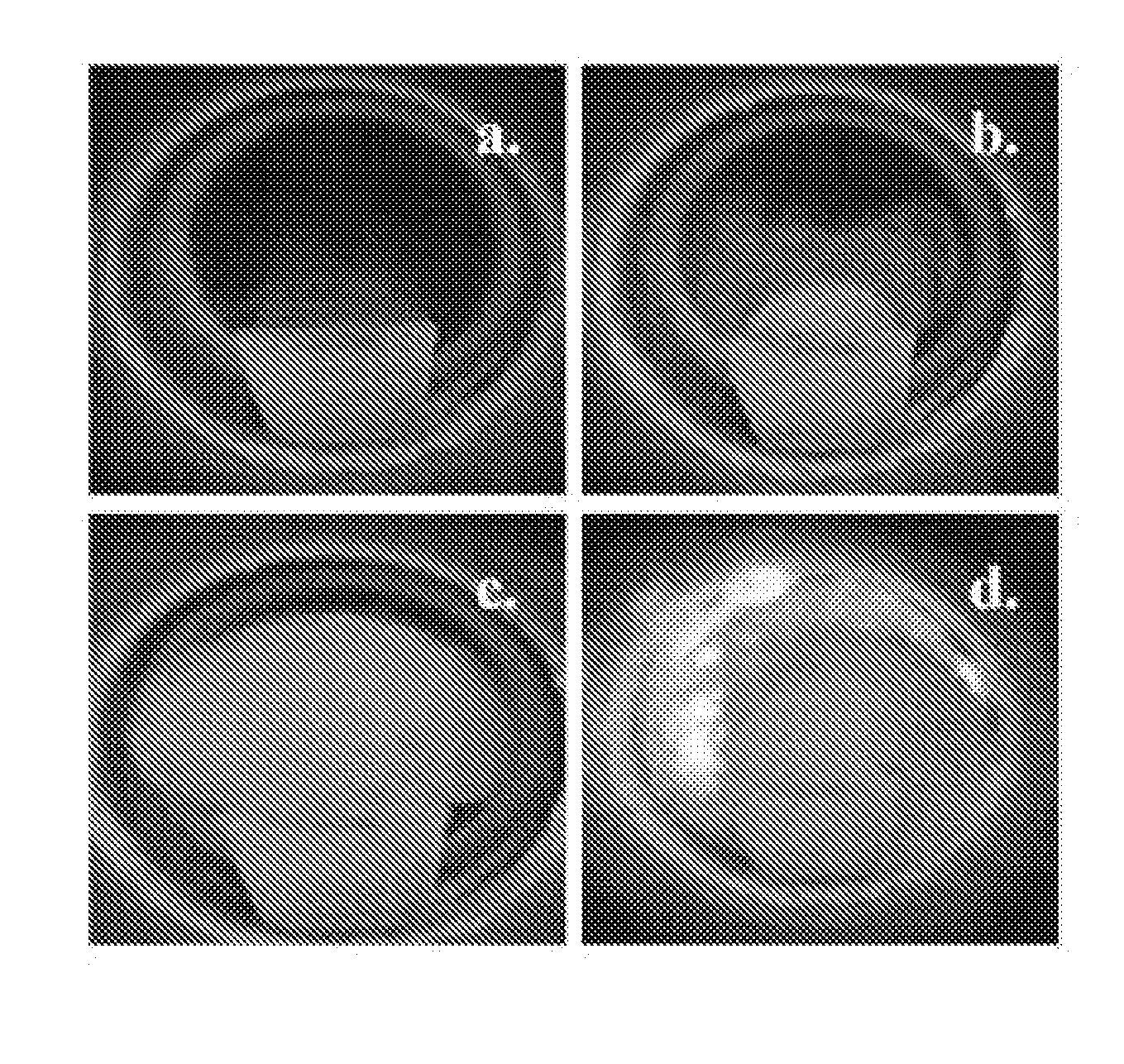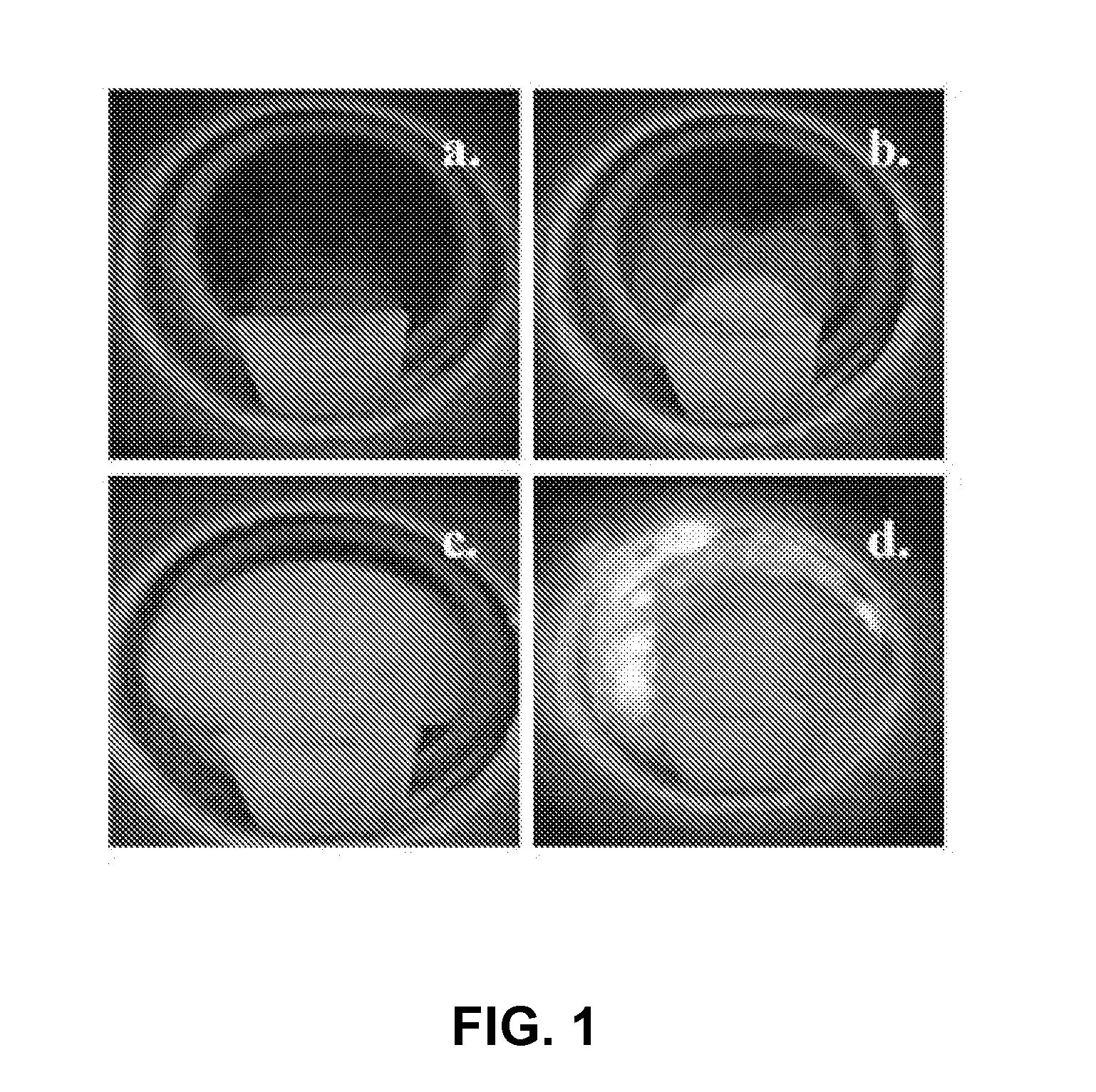[0012]Unless otherwise specified, the metal salt reactant can contain any anion, complexing agent or mixture thereof that allows the metal salt reactant to perform its function in the methods described herein. Some examples of anions are
nitrate,
chloride, and acetate. However, nitrates are particularly useful since most metal nitrates are readily available or easily produced from oxides, are inexpensive compared to pure metal feedstock materials, are very stable, and are very soluble in water.
[0013]Examples of low-cost, readily available, easy to work with organic fuels include
urea (CO(NH2)2),
glycine (C2H5NO2), N-methylurea (CH3NHCONH2),
citric acid (HOC(COOH)(CH2COOH)2),
stearic acid (CH3(CH2)16COOH),
ammonium bicarbonate (NH4HCO3),
ammonium carbonate ((NH4)2CO3) and combinations thereof. Other organic fuels can be used. The reaction can also be carried out in the presence of
nitrogen containing gasifying additives to improve conversion efficiency and speed of reaction. Examples of gasifying additives are
sodium azide (NaN3) and
lithium nitride (Li3N). Other gasifying additives can be used, as known in the art without undue experimentation. Combinations of both metal salt reactants and organic fuels with gasifying additives, if used, along with the temperature profiles can be used to tailor the reducing / oxidation power of the mixture and control off-gas concentrations (i.e. carbon, nitrogen,
hydrogen,
oxygen) that ultimately result in control of
reaction temperature and time as well as product
stoichiometry and particle morphology. There may be
multiple stages in each step where, for example, the reactants are held at different temperatures for different times.
[0016]Powders
ranging in size from micrometers to nanometers can be produced by varying starting reactant
stoichiometry and reactant to fuel mixture ratio, thereby controlling the
maximum temperature observed during the AICS reaction. Generally, lower temperatures prevent the product particles from
sintering. Lower temperatures are achieved by lower than or significantly higher than stoichiometric fuel contents in the mixture, lower ambient temperatures resulting in prolonged duration of
decomposition of the starting reactants, along with slower heating rates or addition of diluents that serve as a
heat sink absorbing energy from the
reaction system. However, higher fuel contents may be required to increase the amount of carbon initially present in the mixture thereby removing
oxygen and producing nitrides. Lower fuel contents will decrease the amount of carbon initially present in the mixture and may produce oxides. These changes can be made by one of ordinary skill in the art using the description provided herein and the knowledge in the art without undue experimentation. Conversely, higher temperatures promote particle
sintering but can result in a loss of sub-micron features and produce a less crystalline phase of the product
powder. Higher temperatures are achieved by fuel contents closer to the stoichiometric value of the mixture, higher ambient temperatures and heating rates that increase the rate of reactant
decomposition and pre-heat, as well as ensuring full conversion of the reactants to the desired products by careful selection of starting mixture stoichiometry. These are extremely important
processing parameters and are often overlooked by similar fabrication processes.
[0024]As used herein, “heat treatment temperature” means a temperature above the
reaction temperature where reaction of the formed product species and / or impurities remaining from the initial
chemical reaction continue to or have the potential to continue reacting with the gaseous environment. Generally, the sole purpose of the heat treatment step is to promote complete conversion of the desired product species, for example, by reaction with
anhydrous ammonia or
methane. Typically, carbon and / or carbon containing species are removed during the heat treatment step. Ultimately, a higher or lower heat treatment temperature can control conversion of the final product and / or loss of desired product stoichiometry along with lower or higher, respectively,
impurity contents. These modifications can be made by one of ordinary skill in the art using the description provided here, as well as the knowledge of one of ordinary skill in the art without undue experimentation.
[0025]As used herein, “powder” means a material in a
solid form able to be readily used or able to be readily pressed into a desired shape.
Powder is understood to be different than pieces or bulk structures of product.
Powder can be further milled to a desired size, if need be, but is not necessarily required in the sense of the word used herein.
Powder offers advantages over other material forms (i.e. pieces, structures, etc.) in the fact that powders are able to adapt to a specific profile or shape.
 Login to View More
Login to View More 


